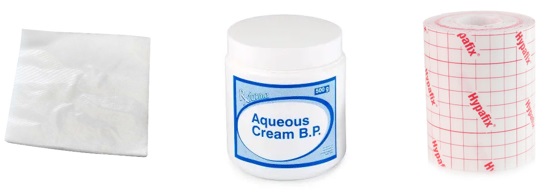Optimising wound healing conditions - "Wet Healing"
It has been known for almost 50 years that the optimal healing environment for epithelialisation and resolution for most primary skin wounds is a moist environment for 24 hours a day for the first few days. A wet healing environment can bring about wound healing and epithelialisation in half the time of a dry environment in both animal and human studies. The theory postulated is that left open to the air or with a dry environment the wound uses its energy and resources to form a scab, when it could be used for more rapid self-debridement and earlier epithelialisation if the wound is covered and moist, and thus the scab formation prevented.
In rugby, we have the added challenge of players wishing to remain active, so wounds that dry out and become brittle (scab) are prone to further injury, particularly if they are stretched by moving joints. This may lead to pain and of course both primary and secondary infection if open wounds are left uncovered and bacteria manage to enter and grow.
Wet healing for abrasions and choice of dressing
Wounds healed by wet healing typically heal in three to five days depending upon size and site as compared to five to ten days for conventional dry healing. There are several differing dressing types that can assist in covering primary wounds and minimising the risk of infection, drying out and optimising faster healing. Two of the most widely available types of dressing would be Hydrocolloid or Hydrogel dressings which are a firm gel-based dressing which prevents loss of further moisture from the wound to maintain a moist environment.
Hydrocolloid dressings are often translucent and can be left for a few days once in situ, as can Hydrogel dressings if they can remain in place undamaged by training. There are however down sides to using sophisticated dressings:
- cost, (especially if the team has frequent skin wounds)
- irregular sizes of wounds (require multiple sizes of dressings)
- the need for frequent replacement (dressings not surviving the rigours of training or play)
- removal of valuable, new immature skin cells when changing the dressing (due to the close adherence of the gel).

Hydrocolloid or hydrogel dressings or creams can be used to promote a wet healing environment.
A simpler, and cheaper alternative is to use a dressing of aqueous unperfumed or emollient cream, and a simple non-adherent dressing that can be re-enforced for training and changed subsequently if it is in poor condition. The cream layer can be preserved to protect the new skin cells much more easily than with adherent gel dressings as it remains in situ as a film if the dressing needs to be changed.

24 hour wet healing cover can be affordably achieved with fixation tape, non-adherent dressings and aqueous or emollient cream, when dressings may need frequent changes. Care should be taken to leave the cream layer intact when changing dressings to avoid removing new skin cells.
Principles of wet healing
- Identify the wounds in the changing room post-match
- Wash visible debris away with tap/shower water
- Place a sterile aqueous cream over the wound (or on the dressing that is going to cover it) e.g., Flamazine or antibiotic ointment
- Cover with a non-adherent dressing
- Re-apply post-training or post-showering so that the wound is effectively covered for 24 hours a day (being careful to avoid showering onto the wound to preserve new skin cells)
- Reassess for signs of infection when changing dressings.

Common knee abrasion treated with wet healing dressings Day 1, Day 3 & 5.
Most abrasions managed in this way will not scab, and pink immature epithelialised skin will be covering the base of the wound at around day three. At this point the wound need only be covered for activity or if re-injured.
IMPORTANT: Epithelialisation does not mean the wound has healed.
Once the new immature skin has grown in, it is important to consider protecting it for another two to three days with a simple dressing to prevent the risk of re-injury until all layers of the keratinised epidermis become re-established and resilient to further injury.
Occasionally, abrasions occur at sites not amenable to dressings or present difficulties with compliance. Scab prevention and a moist environment can still be achieved by directly applying the cream to the wounds.
If wounds are more painful than you would expect or are already showing signs of irritation or potential infection, then antibiotic ointment can be used instead of the aqueous cream. The most important part is that the wound stays covered and has a moist environment in which to heal.

Large significant 3G abrasion of the right leg at day 0 and day 4 treated with wet healing protocol.
Late presentations
If an abrasion presents late e.g., 24 hrs and is still open or if the wound is sloughy or over a high risk area for infection, then a prophylactic more formal topical antibiotic ointment e.g. Chloramphenicol or Fusidic Acid can be used.
Wet healing still is valuable in wounds that have already scabbed, whether due to late presentation or the player having poor compliance with maintaining 24-hour-a-day moist coverage, as the cream will soften up a scab and prevent painful cracking and re-injury.